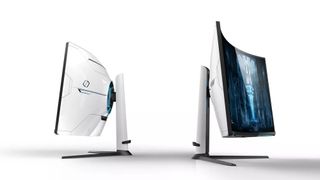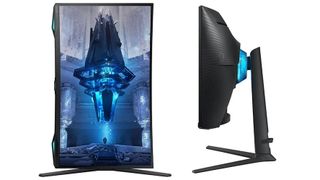Samsung Odyssey Neo G8 4K 240Hz Gaming Display Priced at $1,499, Neo G7 Hits 165Hz
Samsung's Odyssey Neo G8 should hit store shelves next month.

Earlier this year, at CES 2022, Samsung announced the Odyssey Neo G8, which is quite a monumental product in the gaming monitor space. This was among the first 4K monitors announced with a faster than 144Hz refresh rate. And Samsung didn't just tiptoe over the 144Hz threshold; it leaped to 240Hz, which sounds like a good prospect for our best 4K gaming monitors list.
Now, we're learning more about the monitor, including the fact that it will be priced at $1,500 when it launches in the United States in June. We previously learned that the Odyssey Neo G8 features a 31.5-inch Quantum Mini LED panel with a 1000R curve, and now it's been revealed that there are 1,196 individual zones for the backlight. As a result, Samsung boasts a dynamic contrast ratio of 1,000,000:1 with 4,096 steps for brightness control. The Odyssey Neo G8 peaks at an incredible 2,000 nits (350 nits typical) and is DisplayHDR 1000 certified.
The Odyssey Neo G8, of course, supports AMD FreeSync and Nvidia G-Sync Adaptive-Sync technologies and is rated for an MPRT response time of 1ms. Connectivity is plentiful, with two HDMI 2.1, one DisplayPort 1.4, and two USB 3.0 (Type-A) ports. Samsung also says that the Odyssey Neo G8 is adjustable for tilt, swivel, pivot, and height. And given that this is a gaming-centric monitor, RGB lighting effects adorn the exterior to sync with your other peripherals.

But that isn't all that Samsung has up its sleeve; there's also a sister model in the form of the Odyssey Neo G7, according to ComputerBase. The Odyssey Neo G7 also features a 31.5-inch 4K Quantum Mini LED panel with 1,196 local dimming cones, but the refresh rate "only" tops out at 165Hz (which is still impressive for a 4K panel). Typical brightness is the same 350 nits as the Odyssey Neo G8, but maximum brightness is cut in half to 1,000 nits.
Most other specs mirror the Odyssey Neo G8's 1000R curvature, dynamic contrast ratio, response time, Adaptive-Sync compatibility, and port arrangement. However, one visual difference is that the back panel of the Odyssey Neo G8 is white, while the Odyssey Neo G7 is black. Unfortunately, we don't have any information regarding pricing or availability for the monitor.
You’re going to need a sufficiently beastly graphics card to hit the 165 fps mark at 4K that the Odyssey Neo G7 can sustain. However, something like the Nvidia GeForce RTX 3090 Ti, which is among the best graphics cards for gaming, should be up to the task. As for hitting the 240 fps mark with Odyssey Neo G8, perhaps we’ll have to wait to see what Nvidia’s GeForce RTX 40 Series offers on the performance front at 4K resolutions.
Stay on the Cutting Edge
Join the experts who read Tom's Hardware for the inside track on enthusiast PC tech news — and have for over 25 years. We'll send breaking news and in-depth reviews of CPUs, GPUs, AI, maker hardware and more straight to your inbox.
Brandon Hill is a senior editor at Tom's Hardware. He has written about PC and Mac tech since the late 1990s with bylines at AnandTech, DailyTech, and Hot Hardware. When he is not consuming copious amounts of tech news, he can be found enjoying the NC mountains or the beach with his wife and two sons.
-
drivinfast247 That G7 is looking good! I'm not sure if I'll like the 1000r curve, though. I wonder how much cheaper it'll be?Reply -
hotaru.hino 1000R isn't so bad once you get used to it. But going back to a flat panel requires getting used to again.Reply -
docbones69 I am wondering if 31.5 is to small for 4k for daily use. I currently use a 32" at 1440p with 125% scale and thats works out great. I think for 4k, I would want to go more with a 38 inch size.Reply -
hotaru.hino Reply
What's "real work"?valuearb said:I guess no one is going to use this for any real work. -
Krieger6247 Replyvaluearb said:Only 140 DPI?
I guess no one is going to use this for any real work.
No sh*t sherlock, it's a gaming monitor -
blacknemesist That G8 is very tempting with its "on paper" specs but too much of a committement at $1500 without actual user/technical testing. Also its quite sad that for $1500 you can buy a beast of a TV with better specs but can't find anything at 32'', 48'' is the smaller I find and its way too big for the distance it'd be from my eyes. Don't really understand why 4k is suddenly a dry market for PC monitors when we finally have good hardware to drive them and a new gen probably coming this year.Reply -
samopa Replydocbones69 said:I am wondering if 31.5 is to small for 4k for daily use. I currently use a 32" at 1440p with 125% scale and thats works out great. I think for 4k, I would want to go more with a 38 inch size.
I, personally, think 32" with 4K is the sweet spot, I had own the next step size (40") monitor with 4K, and the pixel is too big (blocky) to my taste, so I sold it and rest with 32" 4K monitor until now.
Most Popular


